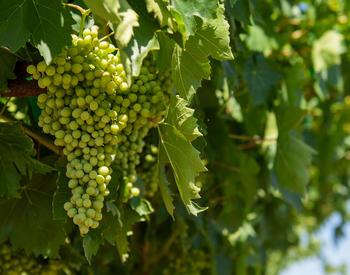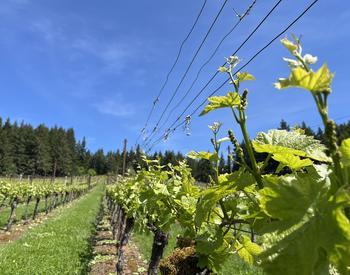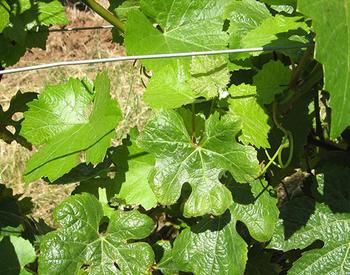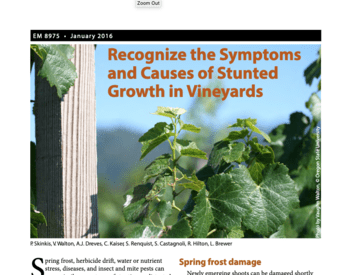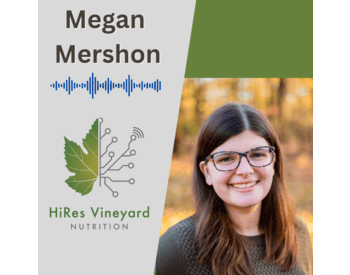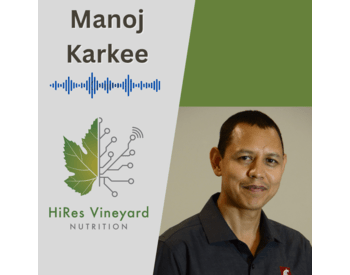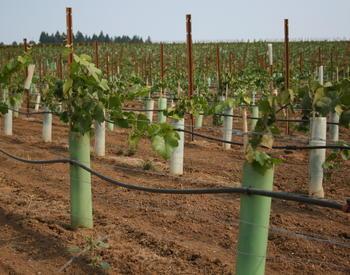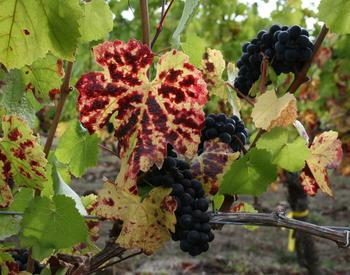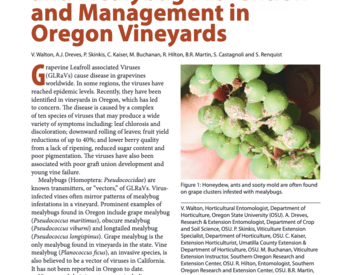Transcript
(00:00:0) Patty Skinkis
This is the High-Res Vineyard Nutrition Podcast, devoted to helping the grape and wine industry understand more about how to monitor and manage vineyard health through grapevine nutrition research. I am your host, Dr. Patty Skinkis, Professor and Viticulture Extension Specialist at Oregon State University.
(00:00:22) Patty Skinkis
Vineyard nutrition is an important part of vineyard health and most grape growers would agree that it’s a foundation to maintaining a productive vineyard. However, it is challenging to know how to best monitor and manage vineyard nutrition amongst different growing regions, climates, weather conditions and crop production goals. While there has been research conducted on vineyard nutrition over the past 50 years, some basic discoveries and refinement of methodology are required. In 2020, a team of fifteen scientists and eight institutions across the US have been working together to address vineyard nutrition through better monitoring techniques and guidelines for grape production across the nation, and all grape markets, including table, raisin, juice and wine grapes. This project is possible through a grant from the National Institute of Food and Agriculture’s Specialty Crops Research Initiative. Here with us today to discuss the research project is Director Dr. Markus Keller. Markus is the Chateau St. Michelle. Distinguished Professor of Viticulture at Washington State University’s Irritated Agriculture Research and Extension Center. He received his Master’s in Plant Science and PhD in Natural Science from the Swiss Federal Institute of Technology in Zurich and has conducted viticulture research and taught in North and South America, Europe and Australia. His research focuses on environmental factors and management practices as they influence crop physiology of wine and juice grapes. He is the author of two textbooks and two volumes of the Science of Grape Vines, which many of you have probably read, and currently serves as a science editor for the two journals of the American Society for Enology and Viticulture.
(00:02:10) Patty Skinkis
Thank you, Markus, for joining us today. I have some questions that I hope will provide the audience with some background on the project and some insight into what’s going on in your research lab in Washington, and some of the bigger takeaways from the project, that we hope, after the next four or five years of the project. But first I wanted to get your take on, you know, how did you decide to lead this big project of eight institutions and fifteen scientists? We know how easy all researchers are to work with, so, tell us a little bit about how you decided to lead this group.
(00:02:49) Markus Keller
Um, it’s just because I love herding sheep. In fact, I grew up herding sheep on a neighbor’s farm with a herd of about 800 sheep, and I would take them up to the Alps and look after them during the summer months while I was in high school and college. But that’s just an aside. In fact, I didn’t decide on leading this group - it was decided for me. I would never have thought to do this. To be honest, it was actually the NGRA, the National Grape and Grape Research Alliance, that contacted me in 2019. They had already developed a pre-proposal, or a project, as part of their Integrated Production Systems Committee, and they approached me and asked if I would lead this project and develop it into something that maybe the SCRI would fund, and they helped assemble the team. You were part of that effort, Patty, as were a bunch of other people across the U.S. They [NGRA] also helped us put together the Industry Advisory Panel for this project. The rest is history. We joked initially that the first year would never get funded. We would just do a round of applications to see how things would work and then revise it the second year. And, what do you know--we got funded the first year, our first approach.
(00:04:14) Patty Skinkis
So, now that you’re leading this big group, I know you’re also involved in a lot of different projects within your own lab, both in the field and the laboratory. Can you tell us in a little bit about the research you’ve been doing for this project?
(00:04:29) Markus Keller
We are working on a mix of field and pot experiments. We have several field trials going on, all of them in commercial vineyards. We’re collaborating with commercial operations/growers out there. Of these experiments we have, we’re testing nitrogen rate and timing of application in Syrah, Sauvignon Blanc and Concord, so, two wine grapes; one red, one white and one juice grape variety. And then we’re also testing potassium rates application in a Chardonnay block, as well. In all of these cases, we’re looking at the effects on growth, yield, of course, yield components, fruit and wine composition, or, I should say, fruit composition. In some cases, like Syrah and Chardonnay, we’re also transporting our grapes from the field side to the Wine Science Center at WSU in the Tri-Cities so that they’re making wine from those different treatments, then they’re looking at wine composition, chemical composition, sensory, and so on. The focus with the nitrogen trials is mostly on phenolics, anthocyanins, tannins, flavanols and so on, versus yeast-assimilable nitrogen, or “YAN,” as people call it. There is this discrepancy, sometimes, between trying to get enough nutrient or nitrogen for the yeast into the must and having too much available so that you have a negative effect on color and tannins and so on in the wine. So, we’re looking at foliar vs soil application of nitrogen, as well as different rates of nitrogen. In the potassium experiment we are looking mostly at the relationship between pH and acidity. When you have too much potassium, sometimes the pH in the fruit in the juice becomes too high and then, even though you have enough acidity, the wine can still be flabby because your pH is too high. Of course, in all these trials we’re also supporting our remote sensing group because that is a big part of this project: to try and remotely sense nutrient status of grapevines using spectral imaging. That’s done by our colleagues from the Center for Precision Agriculture and Automation Systems also at WSU here in Washington. Then, we have other groups in the other states that are doing similar measurements in their production environments.
The final thing that we do as part of these field trials is try to come up with the nutrient replacement budget. That means we’re collecting fruit and leaves at leaf fall. So, fruit would be at harvest and leaves would be at leaf fall, either caused by an early frost or just because senescence the season has been long enough. The leaves are falling off because we’re noticing that growers typically do not consider how much nutrient they are losing when the leaves fall off, and in climates like Eastern WA, where we have a lot of wind, the leaves often end up not remaining in the vineyard. They’re often being blown out of the vineyard and we want to know: how much are we losing? How much do we have to replace? It’s obvious that we should replace what we’re taking out with the fruit that we’re removing from a vineyard for juice or winemaking or table or raisin grapes or whatever. But it’s not so obvious that we should also replace what we might be losing with the leaves. So, those are the field experiments. Then we have some pot experiments, field trials, by the way. We’re just now getting into the second season. We’ve done them for one full year, now this is the second full year that we’re starting. Pot experiments are really just getting started. They’re mostly designed to look at uptake and distribution, especially of nitrogen and potassium. So, when do vines take up most of those nutrients? How do they allocate them to the fruit versus the leaf versus the roots, and so on? And what is the influence of, for example, water deficit or vapor pressure deficit? Water deficit in the soil or in the air which is linked to temperature and humidity. Those are the main things that we’re trying to do with our pot experiments. Just a little fine-tuning of what we’re doing in the field, with more defined treatments and obviously, smaller plants.
(00:09:03) Patty Skinkis
So, your work spans between research for wine and juice grape producers in an arid climate. What is the biggest nutritional challenge faced by each of those groups? Are they the same or a bit different?
(00:09:16) Markus Keller
They’re partly the same and partly different. If we start with wine grapes, one of the biggest challenges in Eastern WA is that 99% of our grapes are grown in Eastern WA where it’s dry and often hot. We had new records last year with temperatures above the 100’s in June and July and we have, on average, only about 8” of rainfall, so it’s very dry. We have to irrigate our vineyards. Under those conditions, we often have very low assimilable-nitrogen in the juice, so often as low as 50 mg per liter, when, for a normal fermentation you’d like to have something between 150 and 250 mg per liter. So, getting enough nitrogen to the yeast during fermentation is a challenge for us under these conditions. At the same time, like I alluded to earlier, when we try to add more nitrogen, we run into potential issues with the color and texture of the wine, mouthfeel and so on. So, we really want to look at that balance between getting enough nitrogen into the grapes for fermentation, but not too much so as to negatively affect wine quality overall. At least red wine quality – it’s a little different in white wines. The second challenge for wine grapes, as I said earlier, is potassium. We often have an imbalance between pH and acidity. So, for example, we sometimes have grapes that have fairly high acidity because we have cool nights, especially during the ripening period, a large diurnal range of temperatures, but still have a relatively high pH and that can be caused by the grapes taking up too much potassium and then putting it into the fruit. So, we would like to know where that problem comes from and what to do about it. And, a new challenge that we have in wine grapes since we have now found Phylloxera in the state. Well, actually it’s been here for over 100 years but it has never spread and now it seems to be starting to spread around a little bit more. Growers are increasingly looking to convert their vineyards from own-rooted vines to grafted vines so we will have rootstocks in Washington that we haven’t had before. Growers don’t know exactly what to do in terms of nutrition or even irrigation and we need to figure out how to fertilize grafted vineyards in the future. When it comes to juice grapes, it’s a little different, but we still have to question about nitrogen. We want, in some sense, plenty of nitrogen. I talked to a grower recently who said he’s using the “More-On” principle when it comes to a fertilizer application. That means he’s putting more fertilizer on just to be on the safe side, right? They want a heavy crop, too. Juice grapes don’t pay a lot. You make money by minimizing labor and maximizing the crop that you get. The danger there is the same as in wine grapes: if you put more N on, that would potentially decrease the color in the juice and color is an important quality criterium even in juice grapes, not just in red wine grapes. So, nitrogen is a big issue for us. The other big one in juice grapes is Iron. We have a lot of vineyards in our climate with very high pH soils. High calcium carbonate, carbonate or lime content in our soils and the vines struggle getting enough Iron into the leaves. So, we have lime-induced chlorosis. We have lightly, light-yellow colored vineyards galore, and we need to figure out how to solve that problem as well. In both cases, wine and juice grapes - so, I talked about the differences; The similarities are that we have a lot of variability. We have vineyards with soil-sand content varying between 10% and more than 90%, so, tremendous variability in soil texture. High variability in soil depth. Anywhere from basically a few inches to many, many feet deep, many yards deep, even, in some cases. So, big variability in soil conditions in our vineyards. More so than even climate variability. That means between vineyards and within vineyards there’s a lot of variation in nutrient availability and nutrient uptake. So, we would like to be able, in the future, to fertilize a little bit more on demand. To put fertilizer on, not just when the vine needs it but also where it needs it in a specific vineyard block, so as to not overapply in some sections and under-apply in other sections of the same vineyard.
(00:14:15) Patty Skinkis
Sounds like major challenges. We’re normally dealing with more climate variability here in Oregon. We still have soil variability, but I think our climate variability is our biggest concern here, so it’s interesting to hear about the vast soil differences.
(00:14:30) Markus Keller
It’s quite different here [eastern Washington]. I mean climate varies everywhere, of course, but here, maybe, the bigger variable might be the soil.
(00:14:38) Patty Skinkis
These are desert conditions in an arid region, less soil organic matter content. How do you think these conditions really impact or make it much more challenging for you to do nutrient management in these vineyards with that high-sand soil, with low soil organic matter? What are the distinct challenges in trying to manage that organic matter? Is it possible to make major changes in your soil organic matter? Or is it something that’s going to be a challenge long-term?
(00:15:10) Markus Keller
Organic matter is a challenge. We have soils that typically have less than 1% organic matter. Sometimes, much less than that. That can be a challenge or a benefit for nutrient management. For example, we have some soils that are almost pure sand, and some growers grow premium, high-end, Reserve quality Cabernet Sauvignon in those soils, but you have to spoon feed vines at that point. You can’t just throw in 100 pounds of nitrogen at the time of bud break and hope everything will be good for the rest of the season. Growers in these conditions use fertigation. They apply nitrogen, for example, in much smaller doses but more frequently, so you have to spread out the applications more over the time of the growing season. Which means you, as a grower, you basically need to know when is the period of high versus low demand. What are those different periods of demand for grapes? When do they need more nutrients at certain times of the year, and so on. But like I said earlier, one of the challenges with these kinds of conditions is that we have low nitrogen in the grapes, low yeast-assimilable nitrogen, we have high soil pH. Often, pH’s of 8 or even 9, in some cases higher than nine that obviously interfere with nutrition uptake, and that’s a problem. We try to use cover crops to counter that problem a little bit. For example, grass-based cover crops that will help to acidify the soil but also release compounds called “siderophores” into the soil. That helps to Iron make more available to grapevine roots. That pH, by the way, has not been a big issue for our wine grape growers with own-rooted vines. That’s one of the things when you have own-rooted vines – they thrive in high pH environments because that’s what they’re used to. From where they evolved way back when, now that we’re going to switch to rootstocks, that will become a much, much more important question. I think we will see more lime-induced chlorosis in wine grapes, going forward, on grafted vineyards, much like we have seen on juice grapes, and that’s a problem that our growers will need to solve.
(00:17:40) Patty Skinkis
Along with the impact of the soils in an arid climate, drought management is always a big part of the nutrient management equation. So, which one do you think is more important for quality grape production? If somebody is strapped for fertilizer resources, or organic growers, for example, that can’t put heavy nitrogen inputs in, which one do you think is more important to manage—the water part of the equation or the nutrition part of the equation?
(00:18:11) Markus Keller
I’m smiling because I view this almost as a trick question. She wants me to say something where I love all my children [vine nutrients] equally, but which one do I like more? But really it depends on the climate and environment. I think our main goal, as viticulturists, is essentially to control vigor. We can control vigor; control the canopy size, the canopy looseness or openness and fruit exposure to sunlight. That’s what in the end comes down to in many cases, and we can do that with either limiting water supply or limiting nutrient supply or both. So, I think in a typical, dry, warm climate like ours or much of California, water supply would be the dominant factor. We control vigor just by turning off the water. In the Willamette Valley, much of the eastern US, northeastern US and so on, nutrient application may become more dominant because there is enough water in the soil, so we’re trying to limit nutrient supply. We have been using regulated deficit irrigation, so every grower knows what I mean when I even mention the term regulated deficit irrigation, but I think maybe we should start thinking in terms of regulated deficit nutrition. We don’t want to starve vines, but we don’t want to give them too much of any particular nutrient. We want to regulate the deficit that we’re applying, but we’re nowhere near knowing what exactly that means in terms of nutrient supply and what it means in a different climate and so on. So, this is a difficult question to answer. I think it really depends on the climate, with water dominating in a dry climate and nutrient application dominating in a more humid climate, if your goal is to control vine vigor.
(00:20:12) Patty Skinkis
I really like the notion of regulated deficit nutrition program as a new way looking forward, because it relates to regulated deficit irrigation. There’s lots of research on it [regulated deficit irrigation], still lots more work that people can do to refine it, but it has that sense of “We’re going to monitor something and then we’re going to tweak it.” I don’t think we are quite there yet and that’s, of course, why we’re doing this research. But I like that idea and that concept. So, also, with respect to the research that’s going on, there’s a lot of work on nitrogen and we recognize that certain areas have to apply more nitrogen, and especially now, with the situation around the world with nitrogen fertilizer prices skyrocketing. How would you advise growers who are wanting to reduce their nitrogen inputs but also know they have to add some?
(00:21:05) Markus Keller
So, not an easy question. We have from one of our field trials last year-- we did a trial with Syrah in a vineyard of St. Michelle Wine Estates--and we applied different rates of nitrogen: soil-based nitrogen around bloom and fruit set, varying from 20 to 80 pounds per acre, and a non-fertilized control. So, quite a large range of fertilizer application, and then we had another treatment where we applied nothing but about just under 15 pounds per acre of nitrogen by foliar application at veraison, split into three doses, but still only 15 pounds per acre at veraison (total), and we found that the impact on YAN, yeast-assimilable nitrogen, was equivalent to 60 pounds of nitrogen applied in the soil as you would apply during roughly that bloom time/fruit set period, when most growers would be ramping up their nutrient supply. So, maybe switching to foliar nitrogen could be one way to, at the same time, control YAN contents in the must. You’re applying something that the grape berry that can still take up and absorb content from the leaves. During the ripening phase, you’re beefing up nitrogen content in the berry, while at the same time you’re not increasing the nitrogen content necessarily in the rest of the vine, because you’re only applying a much smaller dose compared with what you would be applying in the soil. So, it seems it might be much more effective to focus a little more on foliar nutrient applications at the expense of soil-based applications, but we have to be careful not to overdo it, because the vine doesn’t allocate nitrogen just to the berry. It doesn’t grow nitrogen just for the yeast, it also needs nitrogen to grow the plant, so we cannot really go too low, but, we just don’t know yet how low enough is. One way is to focus a little more on foliar applications and then also apply fertigation where you can apply small doses just at the right time, instead of just using one single dose. We still have growers that apply broadcast fertilizer applications at the time of budbreak and I just don’t think that’s a viable strategy. You need, again, the “More-On” strategy to get enough nutrients into the soil at that time so that at least the vines will take some of it up before the rest of it gets leached out and ends up in the groundwater. So that is not a viable strategy in terms of sustainability and in terms of environmental stewardship. It’s also not viable for you, just for your pocketbook, because you’re potentially wasting on a lot of nutrients. So, I’m strongly advising against broadcast applications of fertilizer, especially if they’re applied early in the year during dormancy. But I’m much more in favor of applying smaller doses, maybe more frequent doses, through a fertigation system if you can, and if you’re set up for that.
(00:24:22) Patty Skinkis
So, when it comes to the fertilizers that can be used by Organic growers, when we’re talking foliar, are there products that can be used in the vineyard for Organic growers in the foliar nutrition program?
(00:24:35) Markus Keller
There probably can be, but I’ve not looked into this myself, so I’m a little bit at a loss of how I should best answer this question. But there’s a lot of algae products and so on that contain, some of them contain fairly high doses of nitrogen that probably could be used for this purpose. People would have to figure out exactly when and how much to spray and so on, how much is too much? For example, you can burn off the leaves if you apply too much at the wrong time. Those are things that people need to consider, but there are those products that you could apply for all your sprays.
(00:25:11) Patty Skinkis
So now taking a step back into the larger project. What do you think are the biggest takeaways that Washington producers might obtain from this project, in particular, beyond just your lab but also those of the engineers and researchers across the US?
(00:25:29) Markus Keller
Those will be the takeaways that we have listed in the original proposal, which are the main objectives that we have, and those would be: first of all, revised nutrient standards for tissue sampling. Rather than relying on standards that were developed in the 1960’s, in many cases, for table grapes in California and are willy-nilly applied for all grape types across the nation. So, we want to have nutrient tissue standards coupled with sampling protocols, which would tell you where to sample, when best to sample, what type of tissue to sample. Should you sample petioles or leaf blades? Keep them separate or pool them? Can you sample something else? We’re looking, for example, right now at sampling whole shoots during the shoot thinning pass that growers do early in the season, about now. Why not use some of that tissue that you’re pulling off the vine and analyze it and see if you can predict the nutrition status of the vine or the vineyard at an early stage. So that is our first priority, and hopefully takeaways to revise those tissue nutrient sampling standards and sampling protocols.
A second very, very important aspect of this project is remote sensing. Whether we use a drone overhead, flying over the vineyard or a set of cameras mounted on a tractor or an ATV, a Gator™, it doesn’t really matter, but we would like to use something that remotely senses from a distance, non-destructively, what the nutrient status of a plant, and therefore, of a vineyard, is. For example, if you could mount cameras on a gator, drive up and down the vineyard rows and the camera would pick up some reflected light spectra that are correlated with our nutrient standards that we’re developing from tissue analysis that reflect nitrogen or potassium or phosphorus or maybe magnesium in the leaves. So, remote sensing of nutrients that can then be used to map the whole vineyard, rather than just having a single sample for an entire vineyard block.
You now have a map that details the nutrient status of that vineyard and that is available, hopefully, the next day, so a grower could act upon that map by applying fertilizer specifically where the vineyard, not necessarily the vine, but the vineyard needs that fertilizer. Finally, we want to have recommendations that will optimize nutrient supply by grape, type, or grape market. Whatever you want to call it so “market” meaning wine juice, table or raisin grapes, and by region: warm, dry versus cool, wet – I’ve already mentioned that. For example, we have Chardonnay as a common variety across the different regions in the Eastern US as well as over here in the West, both in eastern Washington and the Willamette Valley of Oregon. Hopefully, by testing the same set of standard protocols on Chardonnay across the nation, we should be able to tell whether something is a soil-based influence or climate-based influence. Do we need to adapt nutrient standards for a single variety depending on the region? Or can we use just a single, one size fits all approach for a specific variety? Those are the main takeaways: remote sensing, revised nutrient standards for tissue sampling and then recommendations for optimizing nutrient supply by grape type, market or maybe, even, by variety, ultimately.
(00:29:33) Patty Skinkis
Well, great. Thank you. One other question I have to end with is kind of a fun question: How did you decide on a career in Viticulture research? I know you went that route for your education, but you know, how did you decide to make this your career and write a textbook about it and update that textbook?
(00:29:53) Markus Keller
Well, that is kind of a fun question, because I have to confession to make: I wanted nothing less than a career in Viticulture. In fact, I have never taken a Viticulture exam in my entire life. I got my degree in agronomy, plant sciences and I just happened to work with grapes for my Master’s degree, which was actually in entomology. I did my Master’s in an entomology department. I was working with spider mites and they were looking at crops. I was working with beans and the other crop was wine grapes that I worked on, and then after my Master’s I went back and my father got ill. I managed the farm at home for a while and kept getting these requests to join the Viticulture department for a PhD, and ultimately, I gave in. I relented, and after that I never looked back. So, my goal was to, first, there were two things in my life that I knew I would never do: First, work with grapes, because I had worked with grapes when I was a kid and that was all I needed; Second, I would never do a PhD, and look where I’m at today. So, you never know what you’re going to get. My advice for young aspiring scientists is: Don’t worry too much about what you’re going to be when you grow up, just walk through open doors if there’s an open door or window. That is an advice that my mother gave us kids when we were little. See if there’s a door, walk through it and see what happens on the other side. But you got to walk through that door. The other advice is: When you finally decide on doing something, do the best you can, do it long enough so hopefully get good at it, and then when you get so good at it you enjoy it more, and when you enjoy it more, hopefully get better at it, still. So, advice number two is: Have fun. Whatever you do, enjoy what you’re doing and do it for a long enough time to get good.
(00:31:5) Patty Skinkis
Well, that’s an excellent story. I love that, Markus, and I guess that “open door” for being the Director of the High-Res Vineyard Nutrition Project was the next open door you needed to branch out in this big research project. Thank you for sharing your time with us today.
If you want more information about the project team, about Markus and what we’re doing, you can go to the High-Resolution or https://highresvineyardnutrition.com, and we have information there, project reports and more podcasts to come will be posted to that website. Thank you, again.
At the helm of the High-Resolution Vineyard Nutrition Project is Director, Dr. Markus Keller, Professor of Viticulture at Washington State University. He describes how he became lead of the project and summarizes the challenges of managing vineyard nutrition in arid eastern Washington wine- and juice-grape vineyards.


